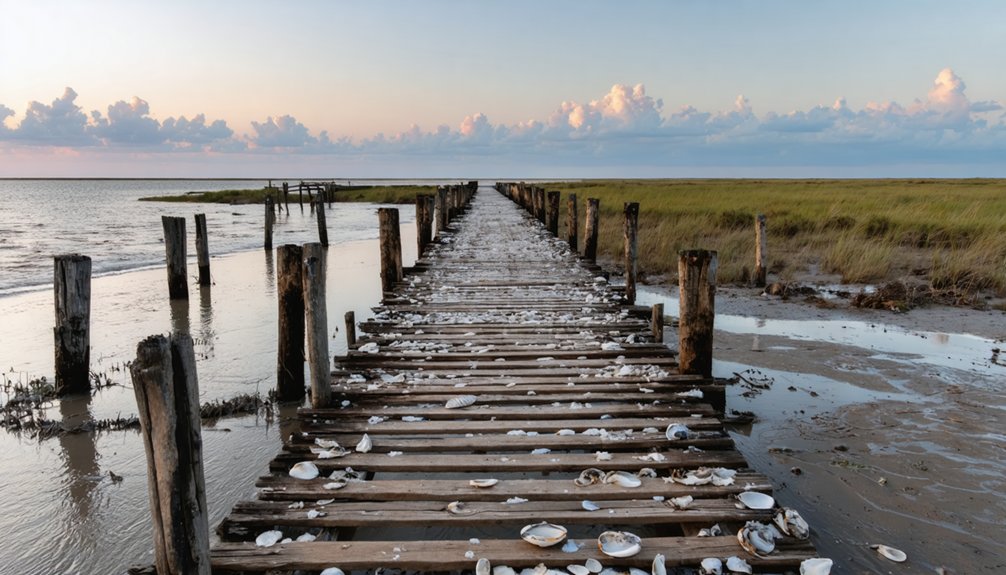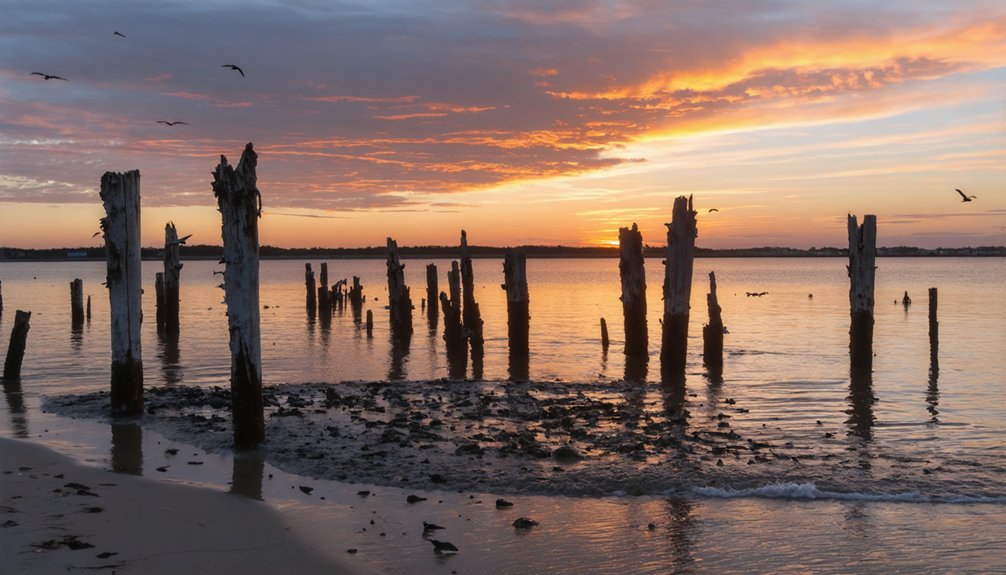You’ll discover the haunting story of Indianola along Texas’s Matagorda Bay, where German immigrants first landed in 1846. This bustling deep-water port quickly grew into Texas’s second-largest city, rivaling Galveston with its advanced shipping facilities and cultural vibrancy. Two catastrophic hurricanes – one in 1875 and another in 1886 – brought devastating 150 mph winds and storm surges that transformed this prosperous coastal hub into one of America’s most dramatic ghost towns.
Key Takeaways
- Indianola was Texas’s largest port city before being completely destroyed by two devastating hurricanes in 1875 and 1886.
- After the second hurricane’s 150 mph winds and 15-foot storm surge, only two buildings remained standing in the entire town.
- The site of former Indianola now lies underwater, with remnants visible during low tide along Matagorda Bay.
- Historical markers, wetland preserves, and a cemetery are all that remain of this once-prosperous German immigration gateway.
- Post-storm fires and the decision not to rebuild after the 1886 hurricane led to Indianola’s permanent abandonment.
From Indian Point to Texas’s Second-Largest Port
When Sam Addison White and William M. Cook founded Indian Point in August 1846 on Matagorda Bay, they’d lay the foundation for Texas’s most ambitious port development.
You’ll find its origins tied to Prince Carl of Solms-Braunfels, who first selected this strategic location as Karlshafen for German immigrants in 1844.
The settlement grew rapidly as it became a crucial deep-water port during the Mexican War, supplying military outposts along the frontier.
The town developed quickly with help from the Aldesverein organization that provided funding for German settlers’ transportation and essential supplies.
Gateway for German Immigration and Western Expansion
The Adelsverein’s vision for German colonization in Texas found its perfect port in Indianola. You’ll find that in 1844, Prince Carl of Solms-Braunfels selected this location, then called Indian Point, as the gateway for German settlers heading west. The society charged families $240 for passage and promised them tools, housing, and support. As a place name disambiguation, the area was known by several different names before settling on Indianola.
German settler experiences at Indianola shaped Texas’s frontier development. By 1846, the port wasn’t just processing immigrants – it’d become a crucial supply depot for western forts. Many immigrants faced dire conditions upon arrival, with makeshift shelters offering little protection from the elements.
The town’s strategic position connected coastal routes with inland trails, while German cultural adaptation flourished in nearby settlements. In DeWitt County, German immigrants became the majority, bringing their trades, farming methods, and traditions.
They’d learn to balance their heritage with frontier life, including interactions with cowboys they called “rowdies.”
The Rise and Fall of a Maritime Trading Hub

Founded in 1846 by Sam Addison White and William M. Cook, Indianola quickly transformed from a settlement known as Indian Point into Texas’s premier deepwater port.
You’d have witnessed rapid economic transformation as the port’s maritime infrastructure expanded with warehouses, docks, and hotels supporting both freight and passenger traffic.
The stagecoach service from Victoria in 1848 helped connect the growing port town to inland Texas communities.
Like other shallow-water ports, Indianola eventually declined as railroads expanded and larger vessels required deeper harbors.
Two Hurricanes That Changed History
Indianola’s maritime prosperity came to an abrupt end through two catastrophic hurricanes that struck the Texas coast eleven years apart.
The first hurricane devastation came in 1875, when 115 mph winds and storm surge claimed 270 lives and leveled half the town. Though residents rebuilt, their hopes were crushed by an even fiercer storm in 1886, exposing Indianola’s coastal vulnerability. In the aftermath of the 1875 storm, extensive looting occurred, leading to the deaths of 15 looters. Originally settled as Karlshaven, the town had grown into a major port city before its destruction.
- Category 3 hurricane (1875) destroyed most buildings and railroad infrastructure
- 270 deaths marked one of Texas’ deadliest storms
- Category 4 hurricane (1886) brought 150 mph winds and 15-foot storm surge
- Only two buildings survived the second hurricane’s fury
- Post-storm fires consumed what little remained
You’ll find Indianola’s ruins beneath Matagorda Bay today, a sobering reminder of nature’s power over human ambition.
Legacy of a Lost Coastal City
Although storms erased its physical presence, Indianola’s rich cultural legacy endures through its pivotal role in Texas immigration and commerce from 1846 to 1886.
You’ll find its cultural heritage woven into the fabric of Texas history, from the German settlers who established thriving communities to the Native American Karankawa who first inhabited the area.
The town’s economic impact resonated far beyond its shores as the second-largest Texas port, connecting the state to global markets through Charles Morgan’s steamship line. The pioneering use of refrigerated beef shipping in 1869 revolutionized the meat trade industry.
While the original town site now lies beneath the Gulf’s waters, you can explore Indianola’s story through museums, historical markers, and protected wetlands. In 1875, a devastating Category 3 hurricane forever changed the town’s trajectory.
The diaspora of its citizens enriched communities throughout Texas, creating lasting influences that shaped the state’s development.
Frequently Asked Questions
What Were Average Property Values in Indianola During Its Peak Years?
You’d find property value trends ranging from $240 for basic land to several thousand for commercial plots, with real estate fluctuations peaking during 1870-1875 when the port reached maximum prosperity.
Did Any Famous Historical Figures Live in or Visit Indianola?
Like ships passing through its harbor, famous visitors included Prince Carl of Solms-Braunfels, Texas heroine Angelina Eberly, and shipping magnate Charles Morgan. You’ll find their historical connections shaped Indianola’s destiny.
What Types of Businesses and Industries Operated in Indianola Besides Shipping?
You’d find hotels, farming operations, railroad services, military supply depots, repair shops, retail stores, fishing industry ventures, and tourism development, along with artisans and mechanics serving the bustling port community.
How Did Native American Tribes Interact With Indianola’s Residents After Settlement?
You’d have seen mostly peaceful interactions through limited cultural exchanges and trade relations, as German settlers maintained diplomatic ties with the Karankawa and Comanche tribes near the growing port settlement.
What Daily Life Activities and Entertainment Were Available for Indianola’s Residents?
You’d spend your days enjoying fishing activities in Matagorda Bay, attending social gatherings at local hotels, participating in German cultural festivals, and watching ships come and go at the bustling port.
References
- https://calhouncountymuseum.org/exhibits/indianola/
- https://www.youtube.com/watch?v=v2JfTPg4z6k
- https://www.tshaonline.org/handbook/entries/indianola-tx
- https://www.texasescapes.com/TexasGhostTowns/IndianolaTexas/IndianolaTx.htm
- https://www.indianolatx.com/history.html
- https://www.texasce.org/tce-news/port-of-indianola-lost-civil-engineering-project/
- https://digging-history.com/2015/08/19/ghost-town-wednesday-indianola-texas/
- https://www.youtube.com/watch?v=vx0YP68sUzQ
- https://texashistory.unt.edu/ark:/67531/metapth860672/
- https://texashighways.com/culture/people/a-relative-of-german-settlers-retraces-her-ancestors-arduous-path-to-the-texas-hill-country/



